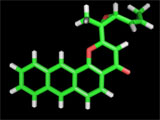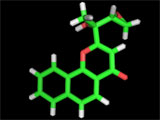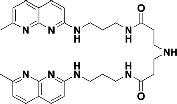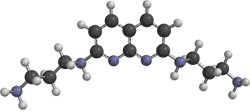| |
 |
HOME > MOLECULE |
| Molecular Gallery |
Molecules we have synthesized for studying interactions to nucleic acids.
1) DNA alkylating intercalator
2) Molecules binding to DNA bulges and mismatches
3) Molecular glue for DNA
4) Fluorescent molecular probes for DNA and RNA
|
| DNA alkylating intercalator |
| A truncated analogue of antitumor antibiotic kapurimycin is an effective guanine alkylating agent. |

|

|
| An enantiomer of this molecule provides important clues toward developing DNA-mismatch binding molecules. (Angew. Chem. Int. Ed. 1999, 38, 3375-3381) |

|

|
| Molecule with enhanced alkylating ability. We have synthesized all possible stereoisomers. (J. Am. Chem. Soc. 2001, 123, 5695-5702)

|
| Molecules binding to DNA bulges and mismatches |
| 1. Molecule binding to guanine bulge ( 2-acylamino-1,8-naphthyridine ) |

|

|
| This molecule recognizes DNA guanine bulge by forming complementary hydrogen bonding between a 2-acylamino naphthyridine moiety and a guanine base. (J. Am. Chem. Soc. 2000, 122, 2172-2177) |
| 2. Molecule binding to G-G mismatch ( naphthyridine dimer ) |


Proper connection between two naphthyridines enables recognition of G-G mismatch DNA. (Nat. Biotechnol. 2001, 19, 51-55) |
| 3. Molecule binding to C-C mismatch ( aminonaphthyridine dimer ) |


2-Aminonaphthyridine dimer recognizes C-C mismatch DNA. Protonated form of 2-aminonaphthyridine forms fully matched hydrogen bonding with cytosine base. (J. Am. Chem. Soc. 2004, 126, 557-562) |
| 4. Molecule binding to CAG/CAG sequence ( NA ) |


This molecule (NA) consists of 2-acylaminonaphthyridine and 8-azaquinolone, which recognize guanine and adenine base, respectively. Although NA was originally designed to recognize G-A mismatch DNA, NA binds to CAG/CAG sequence with much higher affinity. The unique binding mode provided valuable insights into how small molecules recognize DNA. ( Nat. Chem. Biol. 2005, 1, 39-43. )

|
| Molecular glue for DNA |
| 1. Molecular glue for DNA ( NCD: Naphthyridine Carbamate dimmer ) |


NCD binds to G-G mismatch DNA. Since the binding stabilizes the mismatched DNA duplex, NCD can function as a molecular glue to adhere two single stranded-DNAs into double stranded DNA. ( Angew. Chem. Int. Ed. 2006, 45, 5623-5626. ) |
| 2. Thermally degradable molecular glue ( TD ) |


Thermally inactivation of the molecular glue TD enables us to control DNA hybridization/ dehybridization cycles. ( ChemBioChem 2007, 8, 483-485. ) |
| 3. Photoswitchable molecular glue ( NCDA ) |


Integration of the molecular glue with a photochromic azobenzene provides a photoswitchable molecular glue (NCDA) that can reversibly control DNA hybridization/dehybridization by external light stimuli. ( J. Am. Chem. Soc. 2007, 129, 11898-11899. )

|
| Fluorescent molecular probes for DNA and RNA |
| 1. Fluorescent cytosine bulge binding molecule ( DANP ) |


DANP binds selectively to DNA cytosine bulge with a characteristic fluorescence. The unique fluorescent property enables us to monitor a progression of PCR. ( Bioorg. Med. Chem. 2005, 13, 4507-4512. )
|
| 2. Fluorescent indicator for ligand-RNA interactions ( X2S ) |


X2S binds to unpaired regions (bulges & loops) of RNA with decreasing its fluorescence. We developed X2S fluorescence displacement assay for evaluation of ligand-RNA interactions. ( J. Am. Chem. Soc. 2010, 132, 3660-3661. )

|
| |